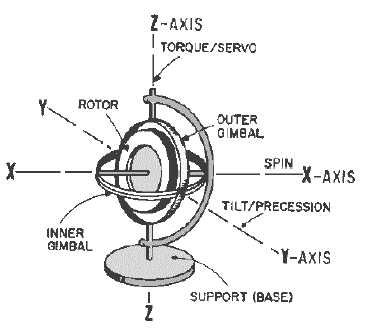3-5
Figure 3-5.—Basic universally mounted gyro.
As you know, gravity is a force that acts along parallel lines upon each particle of matter. A plot of
the resultant gravitational force on a body such as a gyro would be equivalent to the sum of these separate
forces. The point at which the resultant force is applied is called the CENTER OF GRAVITY. To have a
balanced gyro, the center of gravity must be located at the intersection of the three axes of the gyro.
RIGIDITY
A gyroscope is a spinning body that tends to keep its spin axis rigidly pointed in a fixed direction in
space. What do we mean by "fixed direction in space"? A fixed direction on Earth is by no means fixed in
space, because the Earth turns once on its axis every 24 hours, and makes a complete revolution around
the sun every year. The sun itself is moving through space, taking the Earth and the other planets with it.
Because of these motions, the expression "fixed direction in space" as used in this explanation is
theoretical. For all practical purposes, we can say a line from the Earth to a distant star is a fixed direction
in space. If the spin axis of a spinning gyro is pointed at a distant star, it will remain pointed at the star as
the Earth turns.
Gyro rigidity is the strength with which a gyro resists any external force that would tilt its rotor spin
axis. There are three factors that determine gyro rigidity: weight of the rotor, distribution of this weight,
and rotor speed.
The gyro can be considered as an enclosed mechanical system. The energy in the system is equal to
the input energy. Hence the energy necessary to spin the gyro rotor is contained in the rotor as angular
momentum, which is a function of rotor weight and the speed of rotor rotation. The heavier the gyro rotor,
the larger the torque necessary to spin it, and the greater the angular momentum of the rotor. If we have
two rotors with identical shapes but different weights spinning at the same velocity, the heavier of the two
will be more rigid in its spin axis since it has the greater angular momentum.


